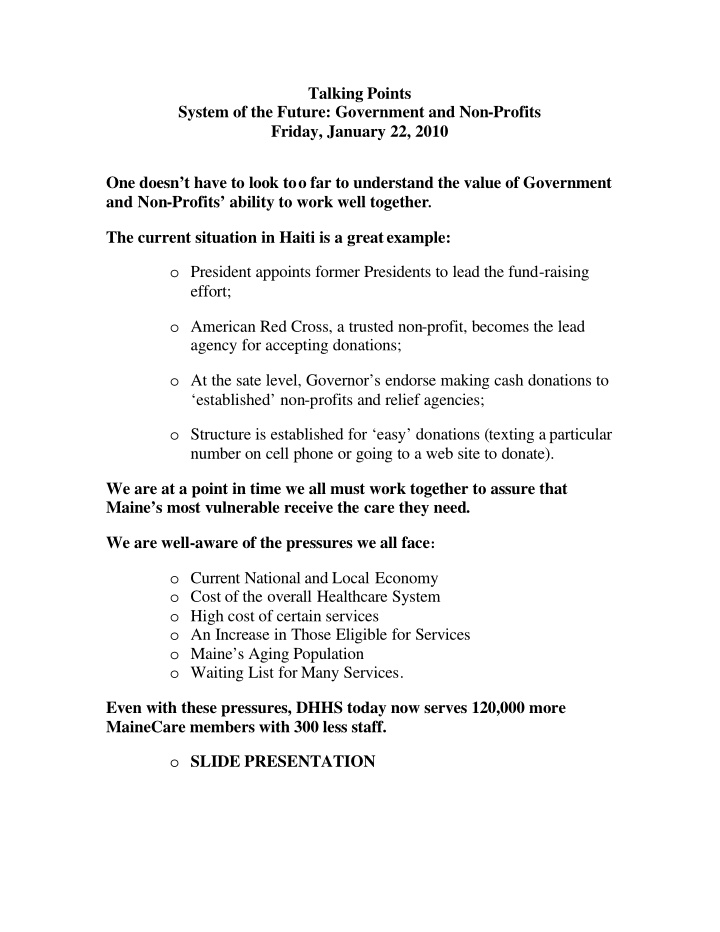



Talking Points System of the Future: Government and Non-Profits Friday, January 22, 2010 One doesn’t have to look too far to understand the value of Government and Non-Profits’ ability to work well together . The current situation in Haiti is a great example: o President appoints former Presidents to lead the fund-raising effort; o American Red Cross, a trusted non-profit, becomes the lead agency for accepting donations; o At the sate level, Governor’s endorse making cash donations to ‘established’ non-profits and relief agencies; o Structure is established for ‘easy’ donations (texting a particular number on cell phone or going to a web site to donate). We are at a point in time we all must work together to assure that Maine’s most vulnerable receive the care they need. We are well-aware of the pressures we all face : o Current National and Local Economy o Cost of the overall Healthcare System o High cost of certain services o An Increase in Those Eligible for Services o Maine’s Aging Population o Waiting List for Many Services. Even with these pressures, DHHS today now serves 120,000 more MaineCare members with 300 less staff. o SLIDE PRESENTATION
The challenge is defining what the core social services are, how we may be able to deliver them efficiently and effectively and maximizing the impact of the funding that does exist. o Our priorities continue to be assuring that people have access to food, shelter, protective services and medical care . o Priority has been given to preserving state dollars to draw matching federal funds for MaineCare programs and other jointly funded federal programs, like child care. Budget Aside, What Does the Ideal System Look Like? As a starting point, I believe these are key elements to an effective system. Many are in place today: o Core services are well-defined . o The system is based on cooperation and integration – one where the public and private sector work together . - Example: Educare . o These professional relationships involve honest, de- personalized dialogue, listening, problem-solving . o Duplication of services is a thing of the past . o More funds are used for direct service and administrative costs are contained. o Services are based on best practices with measurable outcomes that apply to each service. o Services that produce the best outcomes remain part of the system; those that prove to be ineffective are eliminated . o Federal funds are leveraged at the highest level. (Matching funds and grants). o System will dovetail with national health care reform efforts.
o Ultimately, the system will deliver the right service at the right time for the right duration of time and the right cost . o Community involvement is pivotal to success : Example: Community Partnerships for Protecting Children in the Portland Area . The project began as pilot project in two Portland communities, with the goal of reducing childhood abuse and neglect. Initial funds came from several areas DHHS and Casey Family Services being two of them. Collaborators included many – o Child Welfare and Children’s Behavioral Health staff , o the local Children’s Advocacy Council , o Youth Alternatives/Ingraham , o the United Way o Casey Family Services o three neighborhood associations o Portland Health and Human Services, Police, Public Schools o Refugee Services o Juvenile Corrections o South Portland schools, police, city council and city manager o Westbrook police and schools, o Local counseling centers and local residents .
The CPPC now works in four neighborhoods, expanding to South Portland and Westbrook. Recently, Youth Alternatives/Ingraham led the effort to secure a sizeable grant to support employment of youth and young adults . This work has gotten national recognition and attention, along with good results . We need to think about how a system like this can work in the current economic climate: o There must be universal acceptance that ‘business as usual’ will not fly . o We must recognize that no argument can be won by stating that providing a certain service now will save money in the long run. o We must widen our vision of the system beyond the environment we work in each day. o We must work together, be creative within the framework that exists and embrace change . o We must cut cost . o We have to keep our eyes open for those who may fall through the cracks o Maine’s history of neighbors caring for neighbors must remain in place. o We must actively work to sustain and enrich the partnership between ‘the state’ and the not-for-profit community .
Recommend
More recommend